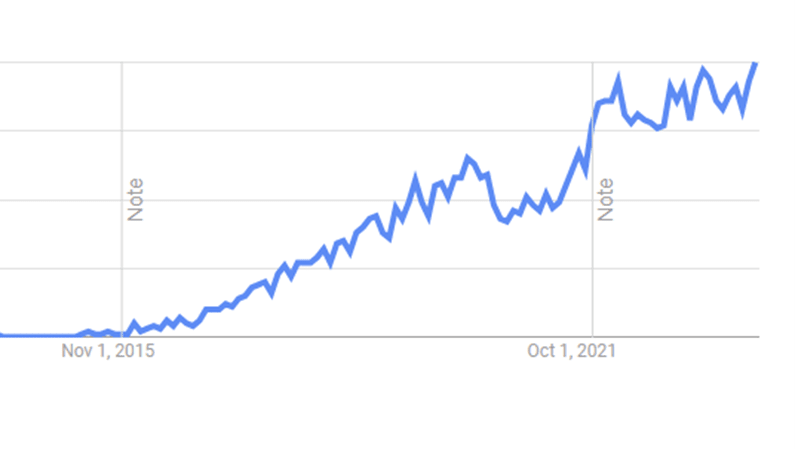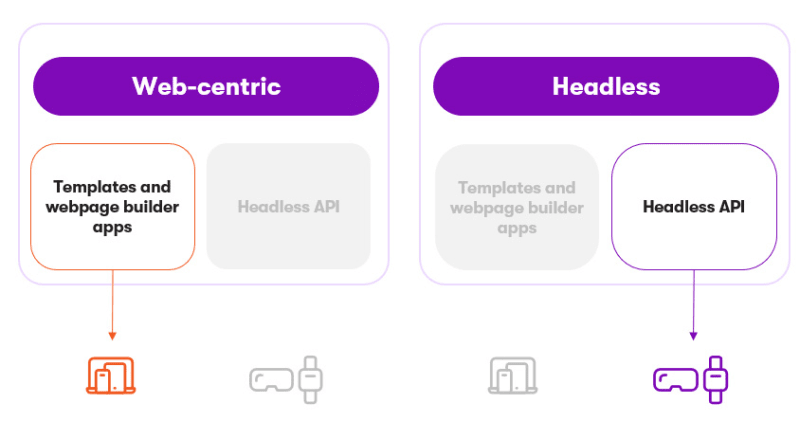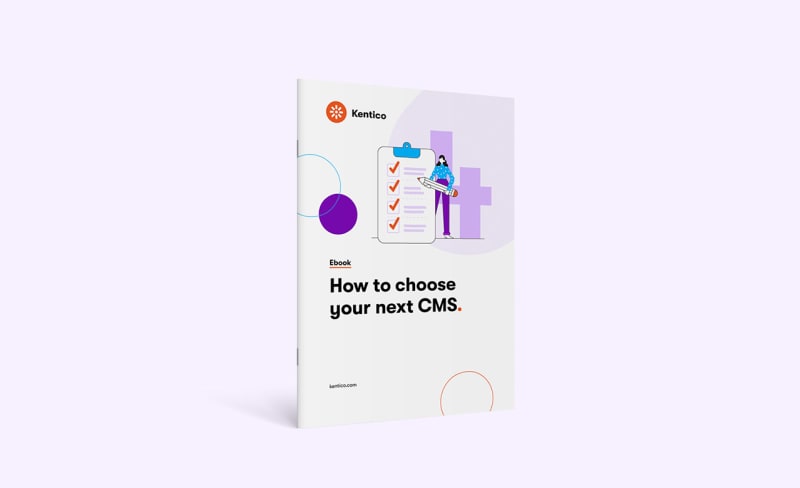People often come to a digital agency and ask for a headless content management system (CMS). They need to manage their web and other channel content and integrate the system with a couple of other technologies. But what does it really take to go pure headless? And is it necessary?
The answer is simple: despite its many benefits, headless architecture is complex, and complexity implies cost. Luckily, there’s a hybrid way, so you can benefit from the flexibility while keeping your system simple.
Headless is a growing trend
Headless software architecture has been hyped over the past ten years, and its peak is still to come, as you can see from the trend of its search volume. No wonder everyone feels they need it to keep pace with the times!

The growing popularity of the “headless CMS” keyword in search (source: Google Trends).
Headless content management simplifies managing content by separating the backend – where content is created and organized, from the frontend – where content is displayed to users.
You can imagine it as two parts of a restaurant – a kitchen is the backend, and a dining area is the frontend. They're separate but work together seamlessly. With headless, marketers can focus on creating and managing content without worrying about how it looks on different devices or platforms because a separate system handles that.

The difference between traditional and headless concepts applied in content management.
Headless CMS promises flexibility and scalability
Benefits of headless CMS:
- Flexible development using the latest technology
- Publishing and reusing consistent content across channels
- Collecting user data from all channels
- The system is scalable, and its parts can be added or changed
Data from all channels in one place
With headless CMS, you can publish and reuse content across various channels beyond just websites and emails. Plus, you get insights into your users’ behavior on all channels and with such knowledge, you can engage your audience with personalized content wherever they are.
Freedom for developers
Developers love using the latest technologies. Headless CMS allows frontend developers to choose any modern frontend framework they like (React, jQuery, etc.).
Pure headless systems mainly benefit large, complex projects such as multi-brand and multichannel communication. Also, enterprises using several modern digital channels such as mobile apps, web apps, and kiosks find headless solutions the most suitable. It's also ideal if you want to design and build a unique, best-of-breed platform.
The costly reality of owning a headless CMS
Before you lose your head over the headless hype, be aware that headless CMS is not a finished product or a single solution. It consists of many parts and requires extensive resources and skills to implement and maintain successfully.
The truth is that headless is far too complicated for most companies who need a CMS solution, mainly for their website and email channels. If you decide to go the headless route, make sure you know what it really entails.
The complex system requires more help from developers
Because headless CMS is backend only (just a kitchen without a dining area), you will need a separate development for the frontend applications (the “head”). Plus, headless solutions usually consist of several technologies, so your developers will need to synchronize your software applications and services and maintain them to avoid disruptions. That’s why you will need a dedicated in-house team or continuous close collaboration with your digital agency.
Less control over the final customer experience
The developers set up how your content is presented online in most headless solutions. As a marketer, you don't have much freedom to change something. If you need a new landing page template, ask your developers for help. And if you want to add a personalized product recommendation, your developers must set it up. That's one of the reasons why headless CMS is not ideal for marketing teams that need to be agile and efficient.
Steeper learning curve
Headless architecture stores content in separate chunks, so your pages are composed of parts such as headlines, intro, descriptions, images, and others. With various apps connected, your editors may take longer to master different user interfaces. In fact, 52% of our survey respondents said their team needed extensive training to master headless CMS.
With headless, you often can’t see what your content will look like until it’s published. This is not an intuitive user experience for editors and it takes time to learn the workflow.
Higher total cost of ownership (TCO)
The complexity of headless systems means it’s more complicated and time-consuming to implement and maintain the solution, leading to higher development costs. According to our research, 62% of companies saw an increase in ongoing costs.
Making sure all parts of the headless system are in sync might need extra tools or software, which costs additional money. Also, training your team can take longer since it involves managing multiple apps and workflows. All these things add up and make the overall cost of headless CMS high and often unpredictable.
Get the flexibility without the cost with a hybrid solution
With its unprecedented flexibility, it’s clear why headless architecture became so popular. But how can you get the benefits without the heavy price tag?
Choose a hybrid solution that grows along your business into a scalable, evergreen digital experience platform. Think of headless as a feature; it’s not the definition of the system but an option.

Choose your way
Hybrid headless platforms such as Xperience by Kentico allow you to set up your main channels in the traditional way and add others as headless. The secret is in a unique way we store content.
Perhaps you want to launch a new website and email marketing quickly and go headless later, or you want to develop a headless platform but manage everything from one interface. Hybrid headless will always adjust, so you can quickly react to the changing market.
Keep the intuitive CMS
Templates and drag-and-drop features are what non-technical editors love so much about traditional CMS. Nobody wants to go to developers every time they need to publish a landing page!
With a hybrid headless platform, you can manage content in a visual editor and publish your content on multiple websites, microsites, and emails. You can also change the template properties and create unique pages without coding.
Get a single content library for all your channels
Like pure headless systems, hybrid headless systems have a central content library – a content hub. This app within the system stores your content items so they can be used on any channel. You can pull it from there into the visual editor, emails, or apps.
When you edit your content in the hub, it will automatically be edited everywhere you've used it. Just imagine how easy it is to change a product description or the title of your article!
Use one solution for a holistic approach
With hybrid headless CMS, you don’t need to compromise on flexibility or ease of use. You get one system for quick-to-be-delivered campaign landing pages and headless channels like apps or in-store kiosks. Hybrid headless means one platform for all. It’s the perfect solution to consolidate and simplify your tech stack.
When starting a new campaign, you can create and publish landing pages, blogs, and emails without needing to work with developers. Everything can be done from one interface. This will save you money on licensing and training while improving productivity thanks to unified UI, UX, and code standards.

Xperience by Kentico offers a breadth of built in content and digital marketing features that can replace a handful of platforms.
Return digital experience creation back in the hands of marketers
A hybrid headless CMS combines the flexibility of headless architecture with the convenience of a traditional CMS. It bridges the gap between the two by offering a single platform for content management and omnichannel delivery.
With a hybrid headless CMS, you can use either or both approaches at the same time. You don’t have to go headless until you’re ready for it. Your marketing team can use a simple interface to create and manage content. They can also take advantage of headless architecture to share content across different channels.
This innovative approach serves most businesses much better than pure headless and allows for easy scalability. In other words, it’s the perfect future-proof solution. It puts digital experiences back in the hands of marketers.
See how it works in Xperience by Kentico. Get our free hosted trial today!

Learn more about selecting the best CMS option for your company with our free ebook, How to choose your next CMS.
Subscribe to the Kentico Xperience newsletter
You'll receive our newsletter once a month with all the updates you need to know to keep you in the loop with the Kentico Xperience community. Just the hits—guaranteed.

